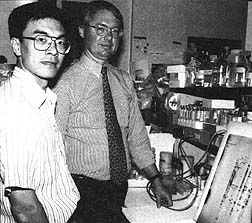The Molecular Neurobiology Branch conducts research on the human genome, the tens of thousands of genes that constitute the genetic blueprint for human beings. The branch takes advantage of technological advances in molecular biology that have made it possible to probe the genes and cellular mechanisms involved in the action of drugs in the brain.
The branch has been a pioneer in cloning the genes of receptor molecules that play an important role in the acute actions of drugs in the brain. In the last 3 years, the Molecular Neurobiology Branch has also focused on investigating long-term changes produced by drug addiction and the genetic bases of individual differences in vulnerability to drugs.
"Cloning the genes for the dopamine transporter where cocaine works and for the mu opiate receptor where morphine works has been an important contribution," says Branch Chief Dr. George Uhl, who also serves as the DIR's acting scientific director. "Based on this work and work by other researchers, we now understand better the exact nature of drug recognition sites for cocaine and opiates in the brain."
 In the molecular neurobiology laboratory, Dr. George Uhl and Dr. Xiao-Bing Wang, a visiting fellow from Osaka University School of Medicine in Japan, are using new molecular biology techniques to display and identify genes that may be regulated by chronic drug abuse.
In the molecular neurobiology laboratory, Dr. George Uhl and Dr. Xiao-Bing Wang, a visiting fellow from Osaka University School of Medicine in Japan, are using new molecular biology techniques to display and identify genes that may be regulated by chronic drug abuse.Using and studying these genetic clones, scientists in the branch have identified several compounds that maintain normal brain function while blocking cocaine analogs from acting at the dopamine transporter. The discovery of these experimental compounds increases the likelihood that scientists will be able to develop clinically useful treatment medications for cocaine addiction, he says.
"We now know a lot about the molecular basis of acute drug-induced euphoria, but long-term changes occur with addiction that may not be totally explained by what's going on at the receptor level," Dr. Uhl says. These adaptive changes in brain cells may contribute to such addiction-related phenomena as drug-seeking behavior, craving, and relapse that occur long after all traces of drugs have been cleared from an individual's system.
To get a handle on what could be the biochemical basis for these long-term phenomena that are associated with drug addiction, the branch has been working to identify genes in the brain that are regulated by abused drugs. In the last 3 years, the branch has identified more than 200 of these genes, Dr. Uhl says. Experiments under way with these genes could provide a better understanding of drug-induced cellular changes and open up the possibility of reversing these changes, he says.
In other research, the branch also is searching for specific genes and gene variations that may contribute to individual differences in vulnerability to drug abuse. This work complements the research of the Etiology Branch, which focuses on the many environmental factors that contribute to drug use and dependence.
"Every human individual and even different animal strains respond differently to drugs, and there is clear evidence that a significant component of this interindividual difference in drug response has genetic bases," Dr. Uhl says. The branch has been conducting animal and human studies using new genetic techniques to identify which genes contribute to differences in drug response and where on the chromosome they are located, Dr. Uhl says.
Identifying drug abuse vulnerability genes could provide markers to identify who might be at greater risk of becoming addicted, more susceptible to certain drugs, or more or less likely to benefit from specific treatments. Ultimately, this knowledge could be used to focus prevention efforts on those people most at risk and to match available therapeutic resources and treatment approaches with those most likely to benefit from them, Dr. Uhl says.
